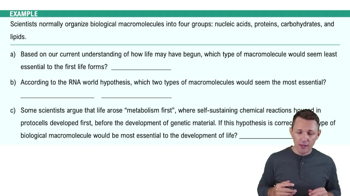Which factor most likely caused animals and plants in India to differ greatly from species in nearby southeast Asia? a. The species became separated by convergent evolution. b. The climates of the two regions are similar. c. India is in the process of separating from the rest of Asia. d. India was a separate continent until 45 million years ago.
Scientists studying the origin of life have accomplished which of the following steps? (A)abiotic synthesis of protocells with self-replicating, catalytic RNA (B)formation of vesicles that use RNA as a template for DNA synthesis (C)formation of protocells that use DNA to direct the polymer-ization of amino acids (D)abiotic synthesis of RNA's bases (A, C, G, U)
 Verified step by step guidance
Verified step by step guidance
Verified video answer for a similar problem:
Key Concepts
Abiotic Synthesis

Protocells

RNA World Hypothesis

Large-scale, worldwide adaptive radiations have occurred in which of the following situations?
a. when there are no available ecological niches
b. after each of the big five mass extinctions
c. after colonization of an isolated island that contains suitable habitat and few competitor species
d. whenever an evolutionary innovation was needed for organisms to thrive
Scientists studying the origin of life have accomplished which of the following steps?
a. abiotic synthesis of protocells with self-replicating, catalytic RNA
b. formation of vesicles that use RNA as a template for DNA synthesis
c. ormation of protocells that use DNA to direct the polymerization of amino acids
d. abiotic synthesis of RNA’s bases (A, C, G, U)
A genetic change that caused a certain Hox gene to be expressed along the tip of a vertebrate limb bud instead of farther back helped make possible the evolution of the tetrapod limb. This type of change is illustrative of a. the influence of environment on development. b. paedomorphosis. c. a change in a developmental gene or in its regulation that altered the spatial organization of body parts. d. heterochrony.
